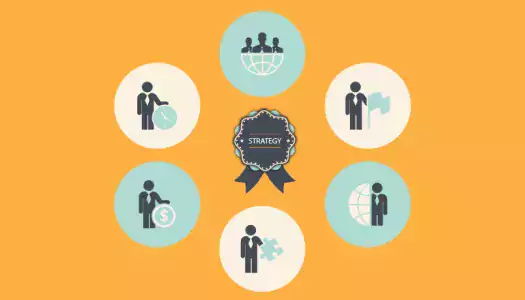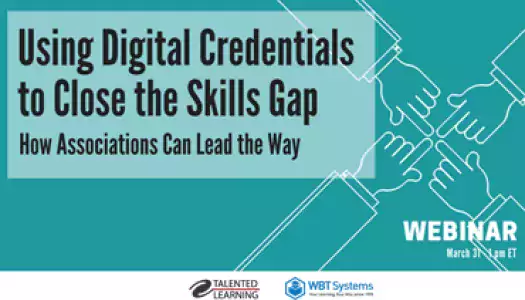If you ever hiked up a mountain without the help of a trail, you know how frustrating and, sometimes, dangerous it can be. You might head off along a ridge in the wrong direction or end up at the bottom of cliff with no way up. A well-marked trail helps hikers get up a mountain efficiently and safely—and well-marked learning pathways helps learners achieve professional goals efficiently too.
A learning pathway is a designated route through online classes, courses, and other educational programs that is designed to help someone achieve a learning goal, for example, prepare for a specific career or update skills. Upon the completion of a learning pathway, the student receives a digital badge, certificate, and/or certification. Learning pathways enhance the value of your online learning programs and increase the loyalty of learners.
Learning pathways at your competitors, LinkedIn and Coursera
LinkedIn offers nearly 60 Learning Paths on their Lynda.com platform for hundreds of careers in design, IT, marketing, business, and more. When a learner completes a path—which can take anywhere from 10 to 68 hours—they can display a digital certificate on their LinkedIn profile.
Coursera recently started offering Learning Paths too. “Learners who tell us that their goal is to start a new career will be shown a complete guide to that career including what skills they need to know, the sequence of courses that teach those skills and even pre-requisites needed to successfully master the skills,” said a Coursera product manager.
These companies know that people need to acquire new skills to hold onto their existing jobs, move into new jobs, and enter new careers. Both LinkedIn and Coursera also offer enterprise plans to companies that need an accessible and affordable source of education for their employees.
Benefits of learning pathways for learners and associations
When you’re usually presented with an overwhelming number of choices for any purchasing or life decision, it’s a relief to have a clear-cut plan laid out for you by a trusted source. A learning pathway provides direction in a confusing employment marketplace to mid-career professionals who need to acquire new skills or young people exploring a new career. No longer do they have to wonder, “Where do I begin? What have others done? What’s the right way to move forward?” They can choose a learning pathway that aligns with their professional goals.
Dan Pink, in his book Drive: The Surprising Truth About What Motivates Us, said science shows that mastery is an intrinsic motivational driver that leads to better performance and personal satisfaction. A learning pathway provides learners a sense of progress and mastery as they make their way through the curriculum.
Self-service and personalization are becoming increasingly prevalent features of online services and products. Although these benefits also appeal to older generations, younger people are accustomed to finding what they need through self-service menus and personalized recommendations for products and services. A variety of learning pathways gives people the opportunity to “choose their own adventure” while working toward their goals.
Learning pathways also help students (high school and college) and young adults understand the different career paths in your industry and the type of skills they need to develop if they wish to obtain a job or enter a career.
Designing learning pathways at your association
Don’t go it alone. Design learning pathways (and your digital badge strategy) in tandem with employers in your industry. They can help you identify the skills and competencies most in demand, those they wished existing employees had, and those needed to enter different types of positions.
Once you identify the goals (learner outcomes) and sketch out the elements of a learning pathway, identify the gaps between your existing programs and the curriculum you’ll need to develop to fill in the pathway.
Will the learning pathway be a purely online learning experience? Or blended? Will you offer some of the classes at conferences and other in-person events?
Think through the experience from the learner’s perspective. Will they have to take each class in order (one as a prerequisite for the next), mix up the order, or test out of a class? Will they have their own online learning community? Will coaching or mentoring be provided as part of the curriculum or for an additional fee?
Will pricing be the same for all classes in the learning pathway? Will you allow learners to bundle classes for a discount?
The learning path experience on Coursera begins with a question about the student’s learning goal: do you want to advance your career, start a new career, or learn for personal enrichment? Their answer acts as a filter and determines which parts of the catalog they see. Will you assist learners in choosing a pathway either by providing some type of self-assessment or coaching?
As learners progress through their pathway, how will you celebrate milestones with them? Certainly a sense of progress can be motivating, but it may not be enough. Identify ways to motivate learners along their pathway.
What will learners receive upon successfully completing a learning pathway? A digital badge? Certificate? Will an exam be required for certification? A learning pathway that culminates in the awarding of a digital badge will help professionals show their competencies in the skills desired by employers. A digital badge program will also help companies in your industry find and hire those qualified employees.
Don’t lay out learning pathways and assume the learners will come and explore them. Develop and continually tweak a never-ending marketing campaign aimed at several audiences: employers (HR departments and management), young adults, mid-career professionals, and professionals in transition.
When your online learning programs help solve the skills gaps in your industry, your association will become the first place people turn to learn more about careers, develop new skills, retrain for new positions, and sharpen their skills.








